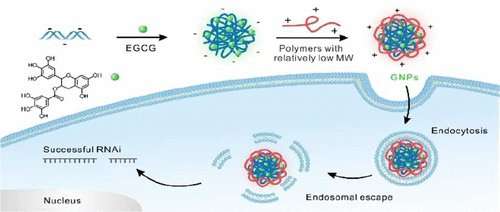Credit: American Chemical Society
Drinking green tea has been linked to health benefits ranging from cardiovascular disease prevention to weight loss. Although many of these claims still need to be verified in the clinic, an antioxidant in green tea called epigallocatechin gallate (EGCG) appears to have beneficial effects in cells and animals. Now, researchers have found a surprising use for EGCG: sneaking therapeutic RNAs into cells. They report their results in ACS Central Science.
Small interfering RNAs (siRNAs) have great therapeutic potential because they can dial down the expression of disease-related genes. However, getting siRNAs into cells where they can do their job has been challenging. Being relatively large and negatively charged, siRNAs cannot easily cross the cell membrane, and they are susceptible to degradation by RNA-chomping enzymes. To overcome these problems, some researchers have tried coating siRNAs with various polymers. However, most small polymers can't shuttle siRNAs into cells, whereas larger polymers can be effective but are generally toxic. Yiyun Cheng and colleagues wondered if they could use EGCG, which is known to bind strongly to RNA, in combination with a small polymer to form nanoparticles that safely deliver siRNA into cells.
The team made their nanoparticles by first combining EGCG and siRNA, which self-assembled into a negatively charged core. Then, the researchers coated this core with a shell consisting of a small, positively charged polymer. These nanoparticles efficiently knocked down the expression of several target genes in cultured cells, showing that the particles could cross the cell membrane. Next, the researchers tested the nanoparticles in a mouse model of intestinal injury, using an siRNA that targeted a pro-inflammatory enzyme. The nanoparticles improved symptoms such as weight loss, shortening of the colon and intestinal inflammation. In addition to the gene-silencing effects of the siRNA, EGCG could contribute to the nanoparticles' effectiveness through its antioxidant and anti-inflammatory properties, the researchers say.
More information: Wanwan Shen et al. Green Tea Catechin Dramatically Promotes RNAi Mediated by Low-Molecular-Weight Polymers, ACS Central Science (2018). DOI: 10.1021/acscentsci.8b00363
Abstract
Cytosolic delivery is the major challenge that limits the clinical translation of siRNA-based therapeutics. Although thousands of polymers have been developed for siRNA delivery, the efficiency–toxicity correlation is unsatisfactory. Here, we report a facile strategy to fabricate core–shell-structured nanoparticles with robust siRNA delivery efficiency. The nanoparticle is prepared by entropy-driven complexation of siRNA with a green tea catechin to yield a negatively charged core, followed by coating low-molecular-weight polymers to form the shell. This supramolecular strategy facilitates the polymers condensing siRNA into uniform nanoparticles. The nanoparticle specifically down-regulates target genes in vitro and in vivo, and efficiently attenuates chronic intestinal inflammation in an inflammatory bowel disease model. Notably, the highly efficient nanoparticles are applicable for various polymers with different topologies and chemical compositions, providing a versatile technique to break down the efficiency–toxicity correlation of cationic polymers. The proposed strategy in this study permits the development of a promising platform for polymer-mediated siRNA delivery.
Journal information: ACS Central Science
Provided by American Chemical Society























